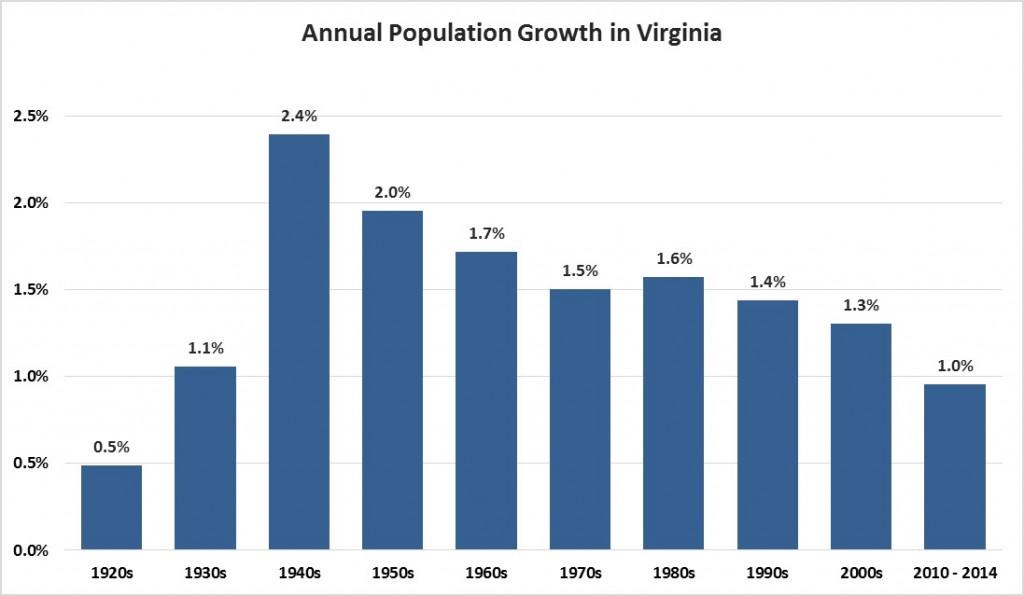The 2010s are not shaping up to be anything like recent decades
Today the University of Virginia’s Weldon Cooper Center released the 2014 population estimates for Virginia’s counties and cities. The most notable trend is that Virginia’s population is growing much more slowly than in any recent decade, at an annual rate of less than 1 percent since 2010. The slowdown can be attributed to both fewer people moving into the state and a shrinking surplus of births over deaths. On the regional and local level, however, the recent slowdown has not been evenly distributed, with many parts of the state experiencing a much sharper shift into slower population growth.

The most obvious reason for Virginia’s recent slowdown in growth would appear to be Northern Virginia, which has been disproportionately impacted by the federal government’s budget sequestration. However, income levels in Northern Virginia remain among the highest in the nation, and unemployment rates are well below the national average. As a result, Northern Virginia continued to account for the majority of Virginia’s population growth in 2014, as it has since the mid-2000s.
Fast and then slow in the exurbs
Instead, the recent slowdown in Virginia’s population growth has been most noticeable in counties located along the edges of metro areas. Until the beginning of the recession, these counties had consistently been among the fastest growing in the state going back to the post-World War II period. Families and retirees moved to exurban areas where they could find affordable housing and still access the jobs and conveniences of nearby cities, and for decades, the populations of these exurban counties consistently grew at above average rates of 20 to 30 percent.


Now even though exurban counties remain attractive, their populations have aged faster than much of Virginia, which means that the death rates are exceeding the birth rates. Without growth from births and fewer people moving to them because of the weak housing market, exurban counties have grown at much slower rates since 2010 than they did during the same period a decade ago.
Growth is accelerating in cities
Unlike most of the state, many independent cities in Virginia have experienced a pickup in their growth rates since 2010. As a group, independent cities are now growing at about the same rate as counties in Virginia, for the first time in over half a century.
One side effect of the weak real estate market has been that more people are renting homes. Cities, which typically have much larger stocks of rental housing, have grown more attractive as a result. But the recent uptick in cities’ growth had already begun during the early 2000s when the real estate market was still strong. Beginning in the late 1990s, many cities in Virginia made significant changes to their zoning and planning process to make development easier, after decades of slow growth and decline in population. Since then, independent cities, such as Richmond and Roanoke have experienced a surge in population growth as empty lots and underused buildings have been redeveloped into new homes.
For some, the slowdown in Virginia’s population growth may be alarming as population growth is often correlated with economic growth. But population growth is usually a result of economic growth rather than the cause of it. And many of the world’s wealthiest countries are also its slowest growing. Though, if population increase is a symptom of economic growth, the sharpness of the slowdown in Virginia’s population growth, particularly during the last few years, may be a cause for concern.
For better or worse, without a considerable reversal in demographic trends over the next five years, much of Virginia will have experienced the slowest decade of growth in many years.
Visit our population estimates page to download the 2014 Virginia county and city estimates or the components of population change data mentioned in this post.


